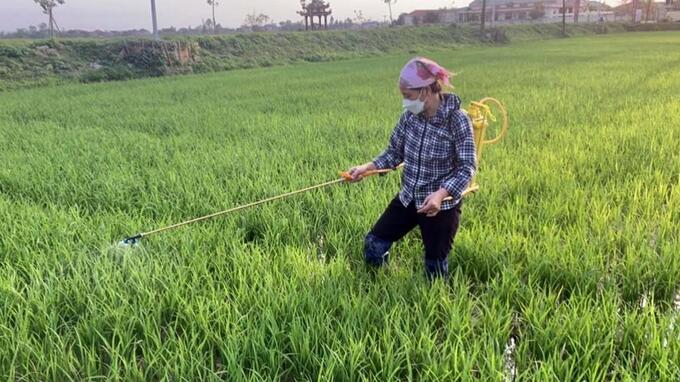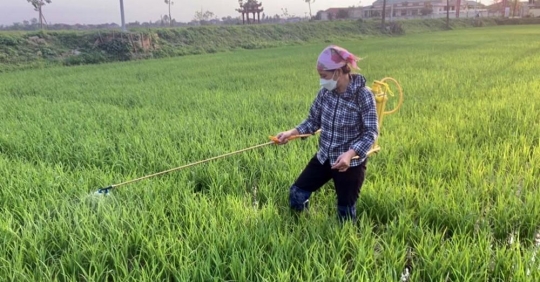The explosion sickness “on time” reappears
At present, the summer rice in Nghe An is at the end of the tillering phase, the sown area will soon start the standing phase. In the past period, complicated weather changes, wet rain, persistent cloudy weather, a lot of fog and high humidity have given the blast fungus a chance to grow and develop, and damaged nearly 450 hectares of spring rice with an infection rate of 10-15 %, especially in places it is higher.

Leaf smut disease has occurred locally in some places in Nghe An. Picture: Phu Huong.
In Hung Nguyen district, in Hung Loi, Hung Chau, Hung Phu, Hung Phuc communes…, the blast disease on the rice field planted early has caused damage to an area of 130 hectares of spring rice. Ms. Nguyen Thi Lien in Hung Loi Township planted 4 Sao rice, now the rice has reached the stage of standing on the pole. Every day she goes to the field to visit the field and take care of the rice, so her paddy field is very good. However, in the past few days, she noticed that all four of her fields were more or less infested with leaf scorch.
Arriving at Hung Nghia Township, not far from Hung Loi Township, Mr. Tran Van Huu said that in the field, some spring rice areas were infected with leaf smut disease, mainly affecting rice varieties TBR225, Thien uu 8, ADI 30 focused…
“This disease is struck almost every year in the spring rice harvest. The best solution is early detection and timely prevention with specific drugs that we are used to, such as Beam 75WP, Filia 525SE … not to spread to a large area and prevent the possibility of the disease later spreading to the cotton neck blast,” added Herr Added Tran Van Huu.
Yen Thanh district, the largest granary in Nghe An province, is also concerned about the risk of an outbreak of explosive disease in the near future. Mr. Le Van Hong, head of the district agriculture and rural development bureau, said that by that date, the leaf smut disease had spread to an area of more than 100 hectares of spring rice in Van Thanh, Cong Thanh, Khanh Thanh, Hop Thanh communes. .., billions The highest rate of infection is 10-15%. The district people’s committee held a session to implement measures to prevent pests in general and the explosion of diseases in spring rice. At the same time, officials from the Ministry of Agriculture and Rural Development and technical personnel from the district agricultural service center have been assigned to communities to visit the fields, check pests and detect them early, together with local officials, especially to prevent blast disease once the disease appears.

Farmers in Hung Nguyen District sprayed spring rice to prevent blast disease. Picture: Phu Huong.
In Dien Chau District, Mr. Le The Hieu, head of the Ministry of Agriculture and Rural Development, said that up to this point in the district, the explosion disease on spring rice has occurred in Minh Chau (20 ha), Dien Nguyen (10 ha). Municipalities.) The technical kit of the Ministry of Agriculture and Rural Development and the district agricultural service center, together with the municipal officials, will go to each municipality for screening, early detection and immediate prevention so that the disease does not have an opportunity to spread to a large one area,” said Mr. Hieu.
At present, Nghe An Sub-department of Crop Production and Plant Protection also has officials in charge of each region, and has coordinated with officials from departments of agriculture and rural development and agricultural service centers of districts, cities and townships to closely follow up investigation and early detection of diseases through to direct prevention.
According to the forecasts of the Nghe An Hydrometeorological Station and the Provincial Subdivision of Cultivation – Plant Protection, the weather in the coming period will continue to be complicated, sunny, rainy, cloudy …, very favorable for explosions disease arise, grow, cause harm and themselves spread over a large area. In particular, special attention should be paid to the area of sandy soils, light meat, semi-mountainous areas, areas with special subclimate due to surrounding paddy fields surrounded by mountains… and annual varieties of rice in spring plants often suffer from severe blast diseases such as IR 1820, BC15, Thien Uu 8, TBR 225, Xi 23, Nhi Uu 986, Nep IR 352, AC5… and on poor soils the fertilization is not balanced and a lot of nitrogen is applied.
Advice on the prevention of blast disease
In order to effectively prevent and control blast disease, farmers should be aware of some basic characteristics of blast disease:

Rice blast is a very dangerous disease and caused severe damage to spring rice in the northern provinces, especially in the north-central region. Picture: Than Nga.
– The disease damages many parts of rice plants such as leaves (leaf smut), cotton neck (cotton smut), buds and rice scorch.
– The disease develops favorably at outdoor temperatures of 20-28 degrees Celsius, humidity above 90% (rain, drizzle and fog…).
– The incubation period is about 5-6 days, depending on the temperature conditions, specifically as follows: from 9-10 degrees Celsius, the incubation period is 13-18 days; from 17 to 18 degrees Celsius, incubation period from 7 to 9 days; from 20-25 degrees Celsius, incubation period of 5-6 days; from 26 to 28 degrees Celsius, incubation period of 4-5 days.
These are important characteristics that farmers must know in order to carry out spraying to kill the disease when the disease is in the acute stage. After the incubation period, the acute disease appears as small brown, squishy spots, at which point the disease has not yet formed spores. With late detection, the disease becomes chronic (having a diamond shape), prevention becomes difficult. At this time, it is necessary to spray twice and spray again after the first spray for 5 to 7 days to be effective, because at this time each disease can release 2,000 to 6,000 spores into the environment.
– Some chemical medicines can be used when spraying to effectively prevent the explosion disease, such as pack, spray evenly on the leaves, do not spray when it rains or right after the rain, the rice leaves are still wet with water.

